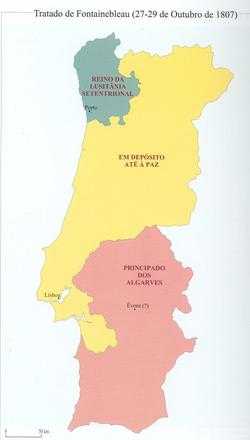Treaty of Fontainebleau (1807)

The Treaty of Fontainebleau was signed on 27 October 1807 in Fontainebleau between Charles IV of Spain and Napoleon I of France. The accord proposed the division of the Kingdom of Portugal and all Portuguese dominions between the signatories.[1] Individuals such as M. Izquierdo, councilor of Charles IV, and Don Manuel de Godoy were also present during the conclusion of the treaty. Based on the first article of the agreement, the King of Etruria would be granted, in exchange for Tuscany, Portuguese territories between the Minho River and the Douro River (i.e. the Kingdom of Northern Lusitania).
The second article of the treaty proposed the establishment of a new Principality of the Algarves, which included the former Kingdom of Algarve and the province of Alentejo.[2]
See also
References
- ↑ Crawley, p. 613. By the Treaty of Fontainebleau (27 October 1807), indeed, Charles IV and Napoleon had agreed to divide between them both Portugal and the Portuguese dominions.
- ↑ Hazlitt, p. 389. Buonaparte was at Fontainebleau in October 1807, when a M. Izquierdo, counsellor to the King of Spain and a creature of Don Manuel Godoi, arrived there to conclude a treaty between the Emperor and his Catholic Majesty relating to the partition of the kingdom of Portugal, which General Junot had just conquered. The first article gave to the King of Etruria in exchange for Tuscany (which Napoleon took to himself and added to the kingdom of Italy) the Portuguese territory lying between the Minho and the Douro; and the second article erected the kingdom of Algarves, including the province of the Alentejo, into a principality in favor of Manuel Godoi, Prince of the Peace. This transferring of sovereignties implies the transferring of subjects; and surely, either one or the other must be wrong, if it can possibly be avoided. Nearly at the same epoch and date as the treaty of Fontainebleau (October 27th) Charles IV. published a royal edict against the Prince of the Asturias (since Ferdinand VII.) and had him arrested and kept him close prisoner in his apartments in the Escurial, as being at the head of a conspiracy to deprive his father of his throne and life. On his begging pardon, however, and disclaiming all intention of violence beyond that of removing the favorite Godoi, he was forgiven and restored to liberty.
Sources
- Crawley, Charles William. The New Cambridge Modern History. Cambridge University Press, 1965. ISBN 0-521-04547-9
- Hazlitt, William. The Life of Napoleon Buonaparte (Volume II). Adamant Media, 2001. ISBN 1-4021-9523-0
- Original text of the Treaty of Fontainebleau, in Spanish "Historia del levantamiento, Guerra y Revolución de España", Count of Toreno (Jose María Queipo de Llano Ruiz de Saravia), Paris, 1838. Google Books.